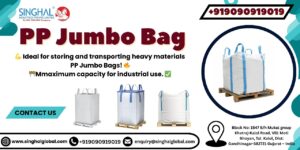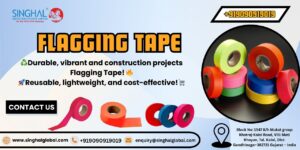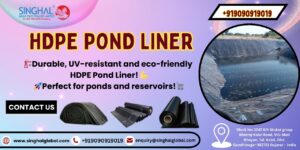Polypropylene, often known as polypropene, is a thermoplastic polymeric material that comes from the polymerization of propylene. It’s a solid substance that’s exceptionally chemically resistant, acids and solvents. These characteristics give it such an excellent material for a large, diverse array of industrial applications. Woven polypropylene is made by weaving polypropylene stripes or threads together through opposing orientations to generate robust, lightweight concrete. This procedure is required for the production of valuable things such as bulk bags.
Packaging Applications for Polypropylene :-
The qualities of woven polypropylene make it very helpful in the packaging business. These characteristics are as follows:
- Non-toxic enables a wide range of alternative uses, including those in the pharmaceutical and food industries.
- Despite its lightweight, it is incredibly sturdy, making it ideal for FIBCs that contain thousands of pounds of stuff.
- Breathable woven textiles are essential for some applications that demand circulation.
- Low cost — the polymer itself is inexpensive, giving widespread access to polypropylene-based products.
- Since woven poly bags are resistant to acids, bases, and many chemicals, they can be employed in therapeutic formulations.
- Obtainable in print
Read More : PP Woven Bags and PP Leno Bags: The Major Differences
Types of PP Woven Bags its Qualities Usage Advantages
Applications of woven polypropylene bags
Packaging for agricultural products
PP woven bags are commonly utilised to handle and distribute farm commodities such as fishery products, food, fruits and vegetables, etc. Vegetable woven bags, Feed PP woven bags, fruit mesh bags, chemical PP woven bags, and fertiliser PP woven bags are examples of PP woven bags used during agriculture.
Geotechnical engineering
PP woven fabrics are widely involved in constructing irrigation facilities, roadways, railways, harbours, mining, and buildings, among other things.
Unique weaved bags
For earthbag structures, a woven polypropylene tube with UV protection can be used.
The following three steps are involved in the production of PP Woven Bag:
- Tape Manufacturing
- Film Extrusion
- Winding Manufacturing Process
PP Woven Bags are often made and imprinted to meet the expectations or wants of the client. End customers employ various colour arrangements and patterns in branding these Bags to transmit the message(s), feature(s), volume and safety details related, and management instructions, among other factors.
Extrusion
Singhal Industries PP woven bags manufacturers entail combining raw resources, beginning with PP or HDPE granules and other chemicals, and forming the raw ingredients into a thread. PP resin is warmed with a CaCo3 feeler and colour, then dissolved and projected as a flat sheet. The slitting unit then slits it into tape yarn, which is extended and cured. The heat-aligned tape yarn is then wound onto a spool by a take-up winder.
Weaving
Weaving yarn into a textile is a method comparable to textile weaving. Circular weaving machines are used to weave these flat strips into circular cloth. The woven circular fabric is then cut to the necessary size. The thread from the bobbin in the creel stand of the circular Loom is woven into cylindrical cloth. Weaving Raffia Tapes into Cloths is done in Circular Looms, which generate Circular Cloth of the appropriate Width. Weaving is a procedure that is both spontaneous and ongoing. The quantity of Circular Looms placed is proportional to the Effective Output of the Raffia Tape Manufacturing Plant. Every Loom’s fabric is constantly coiled on rotating pipes.
Polishing and Sewing
The woven cloth rolls are delivered to the completion & sewing section of the facility. The fabric is cut into small sizes before being published. Following printing, the cut parts are delivered to be stitched. Before sewing the cloth, a valve is constructed in one edge of the cut portion, as requested by the customer. The woven sacks that have passed the quality control test are packed in quantities of 500 or 1000 and pressed on a having to bail press. PP woven bags manufacturers prevent rolled, packaged, packed, and shipped pressed woven sacks for objections; quality control checks are performed every step. Density, tenacity, braking power, and other standards are meticulously followed.
Six-Sigma is applied in a project-oriented manner using the define, measure, analyse, improve, and control (DMAIC) cycle.
- Define (D) The objective of the Define phase is to set clear the challenge, project requirements, and project goals. The project’s goals should centre on significant challenges that are in line with the company’s business plan and the client’s wants.
- Measure (M) The Measure phase aims to completely comprehend recent strength by determining actual success and beginning to monitor it effectively. The measurements employed should be relevant and useful in measuring and evaluating the cause of fluctuation.
- Analyse (A) The data measured in the Measurement process are analysed in the Analysis stage so that theories about the causative factors of differences in the data can be formed and verified. At this point, reasonable business issues are transformed into research methods and evaluated as different techniques.
- Improve (I) The Improve section concentrates on proposing concepts to eliminate the core sources of variance, as well as evaluating and certifying those solutions.
- Control (C) The Control process strives to develop accepted methods to sustain efficiency and fix necessary faults, particularly monitoring system problems.









